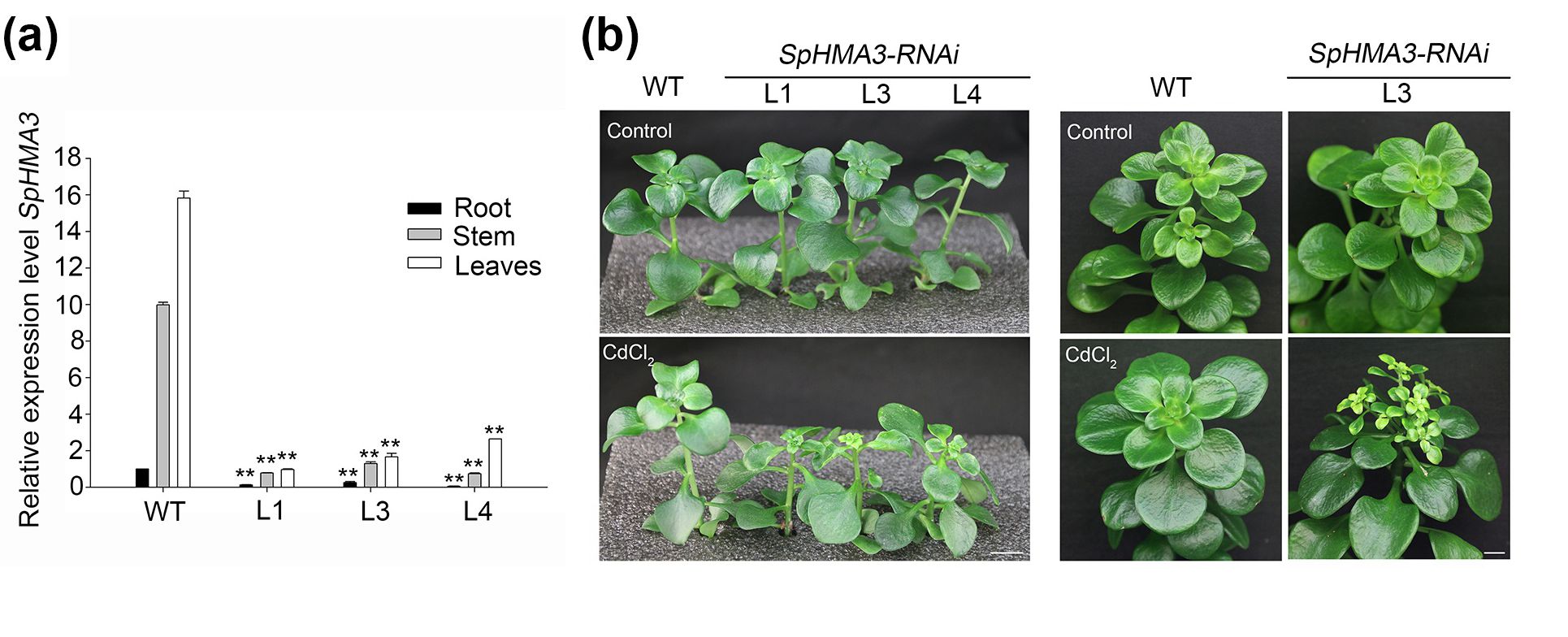Cadmium (Cd) is a nonessential heavy metal element that is highly toxic to almost all organisms, including plants and humans. But some rare plant species can hyperaccumulate Cd in aboveground tissues without suffering from toxicity, which are called Cd hyperaccumulators. Sedum plumbizincicola is a Crassulaceae species native to the Cd/Zn mining areas in southeast China. Because of its strong resistance and hyperaccumulation to Cd/Zn, it is a main phytoremediation species of Cd pollution soil restoration test. However, as a consequence of the lack of transgenic methods for this species, the mechanism underlying high resistance to Cd remains unclear.
Researchers in Prof. WANG Liangsheng’s Group cloned the full-length SpHMA3 gene from S. plumbizincicola, and first developed a genetic transformation system for S. plumbizincicola and the nonhyperaccumulating ecotype of S. alfredii, so RNA interference (RNAi)-mediated silencing and overexpression of SpHMA3 were performed in the Sedum species. They found that SpHMA3 protein was tonoplast-localized and showed Cd-specific transport activity, and SpHMA3 was highly expressed in the shoots of S. plumbizincicola. The SpHMA3-RNAi lines were hypersensitive to Cd, and the growth of shoots and young leaves was severely inhibited by Cd, but did not affect the accumulation of Cd in the aboveground. These results showed that SpHMA3 is a critical gene for Cd detoxification in S. plumbizincicola, and plays an important role in maintaining normal function of young leaves in the Cd contaminated soil.
For the first time, this study directly reveals the molecular mechanisms of hypertolerance to Cd in Cd hyperaccumulators, and established a new model system for the study of Cd and Zn hyperaccumulation.
This work was published in New Phytologist on 2 June, 2017 (http://onlinelibrary.wiley.com/doi/10.1111/nph.14622/abstract) and the genetic transformation method was also published in Frontiers in Plant Science (http://journal.frontiersin.org/article/10.3389/fpls.2017.01047/abstract). The graduate student LIU Huan is the first author of the two papers. Associate Prof. XU Wenzhong is the corresponding author. This research was supported by grants from the National Natural Science Foundation of China and the Knowledge Innovation Programs of Chinese Academy of Sciences.

Fig. 1 Cadmium (Cd) tolerance of Sedum plumbizincicola heavy metal ATPase 3 (SpHMA3)-RNAi transgenic lines.
CONTACT INFO:
XU Wenzhong
Key Laboratory of Plant Resources
Institute of Botany,
Chinese Academy of Sciences,
20 Nanxincun, Xiangshan, Beijing 100093, China
E-mail: xuwzh@ibcas.ac.cn
Cadmium (Cd) is a nonessential heavy metal element that is highly toxic to almost all organisms, including plants and humans. But some rare plant species can hyperaccumulate Cd in aboveground tissues without suffering from toxicity, which are called Cd hyperaccumulators. Sedum plumbizincicola is a Crassulaceae species native to the Cd/Zn mining areas in southeast China. Because of its strong resistance and hyperaccumulation to Cd/Zn, it is a main phytoremediation species of Cd pollution soil restoration test. However, as a consequence of the lack of transgenic methods for this species, the mechanism underlying high resistance to Cd remains unclear.
Researchers in Prof. WANG Liangsheng’s Group cloned the full-length SpHMA3 gene from S. plumbizincicola, and first developed a genetic transformation system for S. plumbizincicola and the nonhyperaccumulating ecotype of S. alfredii, so RNA interference (RNAi)-mediated silencing and overexpression of SpHMA3 were performed in the Sedum species. They found that SpHMA3 protein was tonoplast-localized and showed Cd-specific transport activity, and SpHMA3 was highly expressed in the shoots of S. plumbizincicola. The SpHMA3-RNAi lines were hypersensitive to Cd, and the growth of shoots and young leaves was severely inhibited by Cd, but did not affect the accumulation of Cd in the aboveground. These results showed that SpHMA3 is a critical gene for Cd detoxification in S. plumbizincicola, and plays an important role in maintaining normal function of young leaves in the Cd contaminated soil.
For the first time, this study directly reveals the molecular mechanisms of hypertolerance to Cd in Cd hyperaccumulators, and established a new model system for the study of Cd and Zn hyperaccumulation.
This work was published in New Phytologist on 2 June, 2017 (http://onlinelibrary.wiley.com/doi/10.1111/nph.14622/abstract) and the genetic transformation method was also published in Frontiers in Plant Science (http://journal.frontiersin.org/article/10.3389/fpls.2017.01047/abstract). The graduate student LIU Huan is the first author of the two papers. Associate Prof. XU Wenzhong is the corresponding author. This research was supported by grants from the National Natural Science Foundation of China and the Knowledge Innovation Programs of Chinese Academy of Sciences.

Fig. 1 Cadmium (Cd) tolerance of Sedum plumbizincicola heavy metal ATPase 3 (SpHMA3)-RNAi transgenic lines.
CONTACT INFO:
XU Wenzhong
Key Laboratory of Plant Resources
Institute of Botany,
Chinese Academy of Sciences,
20 Nanxincun, Xiangshan, Beijing 100093, China
E-mail: xuwzh@ibcas.ac.cn
